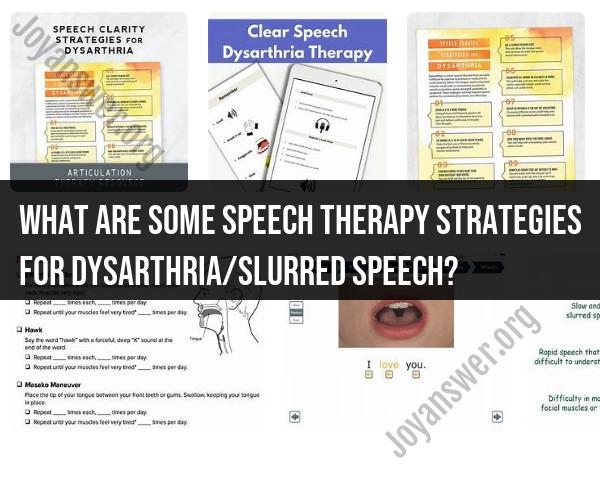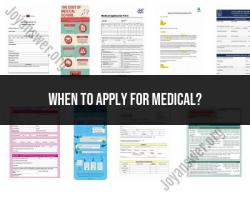What are some speech therapy strategies for dysarthria/slurred speech?
Dysarthria is a motor speech disorder characterized by difficulty in articulating words due to weakness, paralysis, or incoordination of the muscles involved in speech. Speech therapy plays a crucial role in improving articulation and overall communication for individuals with dysarthria. Here are some speech therapy strategies for dysarthria:
Assessment and Individualized Treatment Plan:
- Begin with a thorough assessment to understand the specific characteristics and severity of the dysarthria. Develop an individualized treatment plan based on the assessment findings.
Strengthening Exercises:
- Focus on exercises to strengthen the muscles used in speech production. This may include exercises targeting the tongue, lips, jaw, and respiratory muscles.
Articulation Practice:
- Work on articulation exercises to improve the precision of speech sounds. Practice specific sounds that are challenging for the individual. Use drills and repetitive exercises to build muscle memory.
Breath Support Training:
- Train individuals to use proper breath support for speech. Diaphragmatic breathing exercises can improve respiratory control and support during speech.
Rate Control:
- Work on controlling the rate of speech. Individuals with dysarthria may benefit from slowing down their rate to enhance clarity. Practice speaking at a comfortable and controlled pace.
Intensive and Focused Therapy Sessions:
- Conduct therapy sessions that are intensive and focused on specific speech goals. Regular and consistent practice is essential for improvement.
Visual and Tactile Cues:
- Use visual and tactile cues to assist with articulation. For example, using mirrors allows individuals to see their mouth movements, and tactile cues can provide feedback on tongue and lip positioning.
Augmentative and Alternative Communication (AAC):
- Introduce AAC systems as needed. These can include communication devices, symbols, or pictures to supplement verbal communication, especially if speech is challenging.
Functional Communication Training:
- Focus on functional communication by practicing everyday phrases and situations that are relevant to the individual's needs and activities.
Home Exercises and Carryover Activities:
- Assign home exercises and activities to reinforce skills learned in therapy. Encourage individuals to practice outside of therapy to promote carryover of skills into real-life situations.
Task-Specific Training:
- Engage in task-specific training that involves practicing speech in contexts relevant to daily activities. This helps improve carryover and generalization of skills.
Group Therapy:
- Group therapy sessions provide opportunities for social interaction and practicing communication in various settings. This can boost confidence and motivation.
Ongoing Monitoring and Adjustments:
- Continuously monitor progress and make adjustments to the treatment plan as needed. Dysarthria may change over time, and therapy goals may need to be modified accordingly.
It's important to note that speech therapy for dysarthria should be conducted by licensed speech-language pathologists who can tailor interventions to the specific needs and abilities of the individual. Additionally, involving family members and caregivers in the therapy process can contribute to a supportive environment for communication improvement.
What speech therapy techniques are effective for managing dysarthria or slurred speech?
Dysarthria, characterized by slurred speech, can be caused by numerous neurological conditions affecting muscle control and coordination in the face, mouth, and throat. Though the specific approach depends on the underlying cause and severity, several speech therapy techniques can effectively manage dysarthria:
Articulation Exercises:
- Strengthening: Improve muscle strength and control through exercises targeting the lips, tongue, and jaw.
- Placement cues: Use visual or tactile cues to guide proper placement of mouth and tongue for specific sounds.
- Practice: Repetitively practice targeted sounds and syllables to improve articulation accuracy.
Speech Rate and Prosody:
- Slowing down: Emphasize slower speech rate to increase clarity and control over articulation.
- Pacing: Develop a consistent rhythm and pacing for improved speech fluency and intelligibility.
- Intonation and Stress: Practice using appropriate intonation and stress patterns to convey emotions and meaning effectively.
Respiratory Exercises:
- Diaphragmatic breathing: Strengthen breathing muscles for improved breath support and vocal control.
- Coordinating breath and speech: Practice coordinating breathing patterns with speech production for smoother and effortless speaking.
Non-Speech Oral Motor Exercises:
- Facial massage and exercises: Improve muscle flexibility and range of motion in the face and mouth.
- Blowing exercises: Use blowing activities to strengthen respiratory muscles and improve oral motor control.
- Chewing exercises: Enhance jaw muscle strength and coordination through chewing activities with various textures.
Augmentative and Alternative Communication (AAC):
- Low-tech tools: Utilize picture boards, communication charts, or electronic devices to supplement speech and improve communication abilities.
- High-tech tools: Consider advanced speech-generating devices for individuals with more severe dysarthria.
Additional Strategies:
- Cognitive-linguistic therapy: Address any cognitive or language deficits that may contribute to speech difficulties.
- Counseling and support: Provide emotional support and guidance to individuals and families coping with dysarthria.
- Assistive technology: Utilize voice amplifiers, microphones, or other technology to enhance speech volume and clarity.
It's important to note that the effectiveness of specific techniques can vary depending on the individual and their specific needs. Consultation with a speech-language pathologist is crucial for developing a personalized treatment plan and monitoring progress.
Here are some additional resources for managing dysarthria:
- American Speech-Language-Hearing Association (ASHA): https://www.asha.org/
- National Institute on Deafness and Other Communication Disorders (NIDCD): https://www.nih.gov/about-nih/what-we-do/nih-almanac/national-institute-deafness-other-communication-disorders-nidcd
- Dysarthria Coalition: https://theadultspeechtherapyworkbook.com/dysarthria-exercises-for-adults/
By actively engaging in speech therapy and utilizing appropriate strategies, individuals with dysarthria can significantly improve their speech clarity and communication abilities.













